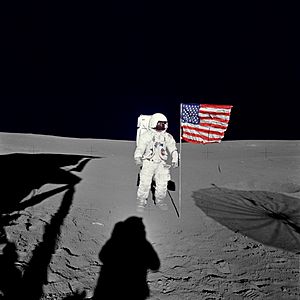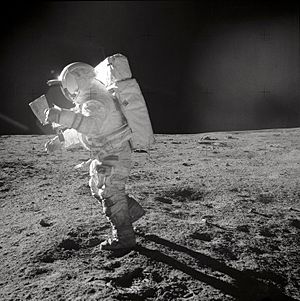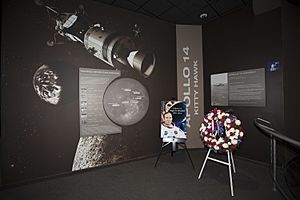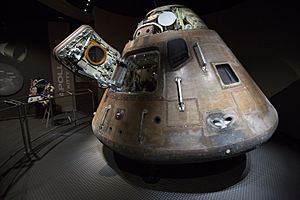Edgar Mitchell facts for kids
Quick facts for kids
Edgar D. Mitchell
|
|
|---|---|
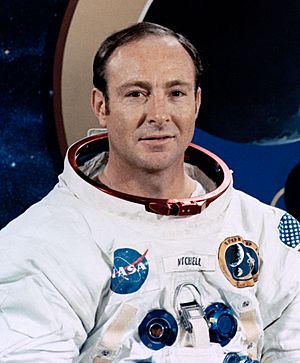
Mitchell in 1970
|
|
| Born |
Edgar Dean Mitchell
September 17, 1930 Hereford, Texas, U.S.
|
| Died | February 4, 2016 (aged 85) West Palm Beach, Florida, U.S.
|
| Other names | Ed Mitchell |
| Alma mater |
|
| Occupation |
|
| Awards |
|
| Space career | |
| NASA Astronaut | |
| Rank | |
|
Time in space
|
9d 00h 01m |
| Selection | 1966 NASA Group 5 |
|
Total EVAs
|
2 |
|
Total EVA time
|
9 hours 23 minutes |
| Missions | Apollo 14 |
|
Mission insignia
|
|
| Retirement | October 1, 1972 |
Edgar Dean Mitchell (September 17, 1930 – February 4, 2016) was an American Navy officer and pilot. He was also a test pilot, engineer, and NASA astronaut. In 1971, he flew on the Apollo 14 mission as the Lunar Module Pilot. He spent nine hours exploring the Moon's surface. Edgar Mitchell was the sixth person ever to walk on the Moon.
Before becoming an astronaut, Mitchell studied at the Carnegie Institute of Technology. He joined the United States Navy in 1952. He became a Naval Aviator, flying planes for the Navy. Later, he earned another degree in aeronautical engineering from the U.S. Naval Postgraduate School. He also got a doctorate in Aeronautics and Astronautics from the Massachusetts Institute of Technology (MIT). He even taught advanced math and navigation to future astronauts.
After his time at NASA, Mitchell became very interested in science and how the mind works. He helped start the Institute of Noetic Sciences. This group studies human consciousness and other related topics.
Contents
Early Life and Education
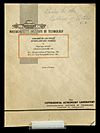
Edgar Mitchell was born on September 17, 1930, in Hereford, Texas. His family were ranchers who moved to New Mexico during the Great Depression. He grew up in Artesia, New Mexico. Mitchell learned to fly planes when he was 13 years old. By age 16, he had his private pilot license. He was also a Boy Scout and reached the rank of Life Scout.
He finished high school in Artesia in 1948. In 1952, he earned a degree in industrial management from the Carnegie Institute of Technology. That same year, he joined the United States Navy. While serving in the Navy, he continued his education. He earned a second degree in aeronautical engineering in 1961. In 1964, he received his Doctor of Science degree from Massachusetts Institute of Technology (MIT).
Flight Experience
In 1953, Mitchell became an Ensign in the Navy. He finished flight training in 1954 and became a Naval Aviator. He flew land-based patrol planes in Okinawa.
Later, he flew jet aircraft from aircraft carriers like the USS Bon Homme Richard. He became a research pilot and flew with Air Development Squadron Five. From 1965 to 1966, he attended the U.S. Air Force Test Pilot School. He graduated at the top of his class. During this time, he taught advanced math and navigation to astronaut candidates.
Mitchell flew for a total of 5,000 hours. About 2,000 of those hours were in jet aircraft.
NASA Career
NASA chose Edgar Mitchell to be an astronaut in 1966. He was part of NASA's fifth group of astronauts. He helped the crew of Apollo 9 and was a backup pilot for Apollo 10.
During the difficult Apollo 13 mission, Mitchell helped the team on Earth. He worked in a simulator to figure out how to bring the astronauts home safely. For his efforts, he received the Presidential Medal of Freedom in 1970.
Mitchell then served as the Lunar Module Pilot on Apollo 14. He landed on the Moon with Commander Alan Shepard on February 5, 1971. They landed in the hilly Fra Mauro Highlands area. They stayed on the Moon for 33 hours. During their time there, they set up scientific equipment and collected nearly 100 pounds of Moon rocks.
Apollo 14 had many achievements. It was the only mission to use the Mobile Equipment Transporter (MET). It was also the first to use color television from the Moon. The astronauts walked the longest distance on the Moon's surface. They also placed the largest amount of equipment into lunar orbit.
Mitchell spent a total of 216 hours and 42 minutes in space on this mission. After Apollo 14, he was chosen as the backup Lunar Module Pilot for Apollo 16.
On the Moon, Mitchell took many photos. One famous picture shows Shepard raising the American flag. Mitchell's shadow is visible near the flag in that photo. Popular Science magazine listed it as one of the best astronaut selfies.
Post-NASA Career
After leaving NASA in 1972, Mitchell became interested in human consciousness and unusual phenomena. He said he had a powerful experience during his trip back from the Moon. He also claimed to have done private ESP experiments with friends on Earth.
He retired from NASA and the U.S. Navy as a Captain in October 1972. Soon after, he started his own company. In 1973, he helped create the Institute of Noetic Sciences (IONS). This institute studies consciousness and how the mind works. Mitchell believed that science and spirituality should be understood together.
In 2011, the U.S. government filed a lawsuit against Mitchell. They wanted him to return a camera used on Apollo 14 that he was trying to sell. Mitchell believed NASA had given him the camera as a gift. They reached an agreement, and Mitchell returned the camera. It is now on display at the National Air and Space Museum. Later, a law was passed confirming astronauts' ownership rights to artifacts from their missions.
Remote Healing
Mitchell believed in remote healing. He claimed that a teenage healer helped him with a health issue from a distance. He said that after the remote healing, the problem was gone.
Views on UFOs
Mitchell often spoke about his belief in unidentified flying objects (UFOs). He said he was "90 percent sure" that many UFOs seen since the 1940s were from visitors from other planets. He believed that governments were hiding the truth about these visits. He mentioned the Roswell crash as a real event involving an alien craft.
In 2008, Mitchell stated on Kerrang Radio that he was "privileged enough to be in on the fact that we've been visited on this planet." NASA responded by saying they do not track UFOs and are not involved in any cover-up. Mitchell clarified that his information came from unnamed sources, not NASA.
In 2015, Mitchell told the Daily Mirror that extraterrestrials were trying to prevent wars on Earth. He said they were interested in atomic weapons testing sites like White Sands.
Other Projects
Edgar Mitchell appeared in several documentaries, including In the Shadow of the Moon (2007). He also wrote books, such as The Way of the Explorer. In this book, he explored his ideas about reality and consciousness.
Death
Edgar Mitchell passed away on February 4, 2016, in West Palm Beach, Florida. He was 85 years old. His death happened on the eve of the 45th anniversary of his Moon landing. Mitchell was the last surviving member of the Apollo 14 crew.
Organizations
Mitchell was a member of many organizations. These included the American Institute of Aeronautics and Astronautics and the Society of Experimental Test Pilots. He was also part of The Explorers Club and the World Futures Society.
Awards and Honors
- Presidential Medal of Freedom (1970)
- NASA Distinguished Service Medal
- Navy Distinguished Service Medal
- Air Medal
- National Defense Service Medal
- China Service Medal
- Navy Astronaut Wings
- Inducted into the International Space Hall of Fame (1979)
- Inducted into the United States Astronaut Hall of Fame (1997)
He also received honorary doctorates from several universities. These included New Mexico State University and Carnegie-Mellon University.
In Media
In the 1998 HBO miniseries From the Earth to the Moon, Edgar Mitchell was played by actor Gary Cole.
He was also featured in Chris Wright's book No More Worlds to Conquer. In the book, Mitchell discussed his beliefs about aliens and the power of the mind.
Books
- Psychic Exploration: A Challenge for Science (1974)
- The Way of the Explorer: An Apollo Astronaut's Journey Through the Material and Mystical Worlds (1996)
- Earthrise: My Adventures as an Apollo 14 Astronaut (2014)
See also
 In Spanish: Edgar Mitchell para niños
In Spanish: Edgar Mitchell para niños


